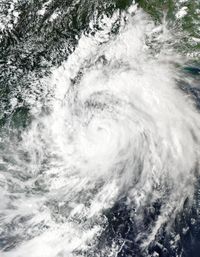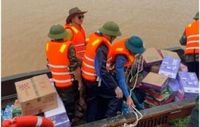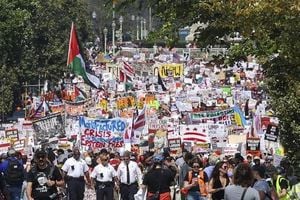On the morning of September 30, 2025, as dawn broke over northern and central Vietnam, the aftermath of Typhoon Bualoi was painfully clear. Streets in the capital, Hanoi, looked more like rivers than roads, and communities across provinces like Thanh Hoa, Nghe An, and Ha Tinh were submerged beneath muddy waters. The storm, which made landfall late on September 28 with winds reaching 130 kilometers per hour, had already left a trail of devastation in the Philippines, killing at least 27 people there before barreling into Vietnam and claiming another 26 lives, according to Vietnam's Environment Ministry and reports from Agenzia Fides and Mission Network News.
As of September 30, the official death toll in Vietnam had risen by four overnight to 26, with another 22 people still missing and roughly 105 reported injured. The numbers were grim, but they only told part of the story. The national weather agency warned that rainfall had exceeded 300 millimeters (about 12 inches) in some areas over the previous 24 hours, fueling fears of continued flash floods and landslides. In Hanoi, residents described the city as “a big pool”—its worst flooding since 2008, with images circulating on social media showing military trucks ferrying children through waist-deep water and parents pleading for help in other neighborhoods.
The human impact was equally harrowing outside the capital. In Thanh Hoa province, Catholic volunteers from the "Sharing Life & Smiles" group braved the floodwaters to bring aid to stranded families in An Cu parish. Many people were still marooned on rooftops as the volunteers delivered 300 boxes of instant noodles, drinking water, and medicine. “It wasn’t just a matter of distributing essential goods, but also hearts filled with boundless love,” reported Agenzia Fides, highlighting the solidarity and compassion that emerged amid the disaster.
The storm’s fury was felt across a wide swath of Vietnam, particularly in Quang Binh, Nghe An, Thanh Hoa, and Ha Tinh provinces. According to the Department of Natural Disaster Prevention, 11 of the 26 victims were killed by a tornado in Ninh Binh, while others lost their lives to floods, landslides, falling trees, and collapsed houses. Among the missing were 12 fishermen from Ho Chi Minh City, who vanished while seeking shelter in the waters off Quang Tri, central Vietnam.
Infrastructure and daily life ground to a halt. Vietnam Airlines canceled or rescheduled several flights at Hanoi’s Noi Bai International Airport, citing dangerous weather conditions that affected visibility and operations. Vietnam Railways Corp suspended most of its trains between Hanoi and Ho Chi Minh City, further isolating communities already cut off by floodwaters. State media and social media overflowed with images of flooded streets, stranded cars and motorbikes, and residents unable to reach their workplaces or return home.
By the numbers, the destruction was staggering. More than 137,000 homes were damaged or had their roofs torn off—mainly in Ha Tinh, Lao Cai, Nghe An, and Thanh Hoa—while an additional 3,370 homes were flooded and 2,700 were completely cut off from the outside world. Over 25,500 hectares (about 63,000 acres) of rice and crops were inundated, and more than 8,700 hectares of fishing grounds were lost. According to Mission Network News, over 44,000 homes and 14,000 acres of crops were harmed in the immediate aftermath, with the risk of further flooding and landslides looming as heavy rains continued.
The Vietnamese government responded by mobilizing tens of thousands of people, including security forces, volunteers, and members of the Civil Defense Force, to provide rapid assistance. Prime Minister Pham Minh Chinh ordered emergency aid and emphasized, “No one should be left without food, drinking water, shelter, and other essentials. Schools and medical facilities must be restored by October 5, 2025, with priority given to poor and vulnerable families.” Relief efforts were complicated by the ongoing rains and rising water levels, making it difficult—or sometimes impossible—for aid workers to reach those most in need.
Religious and civic organizations stepped up in a big way. Caritas Thanh Hoa, a Catholic charity, distributed essential supplies in Kien An parish on September 29, even as floodwaters made access nearly impossible. The following day, as waters began to recede in some areas, volunteers used boats to deliver aid in the Nong Cong region, where water had reached the roofs of houses, leaving families completely isolated. The Jesuit Council for Social Apostolate in Vietnam called on Catholic communities across the country to contribute both material and spiritual support, and images of the devastation filled social media, rallying further assistance from within and outside Vietnam.
Pastor Loc Lam from A3 in Vietnam highlighted the ongoing need for relief: “Many of them lost their houses. There’s no house to stay [in], and no food, no clothing,” he said, urging prayers and continued support for the affected communities. “We are connecting with those who are in this crisis, so that we can see how we can supply rice, clothing and accommodation for them,” he told Mission Network News. He also noted the importance of working together: “The government [is] trying their best as well, with the NGOs and organizations, even with different religions, to raise fund[s] and support the people in those places. Please pray for cooperation among the government and organization[s], even churches and religions, to work together to help the people overcome this type of situation.”
Vietnam’s vulnerability to typhoons and tropical cyclones is well known, with a season that typically runs from June to November. The memory of Super Typhoon Yagi in September 2024—when over 320 people died in Vietnam alone and hundreds more across Southeast Asia—still lingers. Economic losses from that storm were estimated at $3.3 billion. Now, as Typhoon Bualoi’s toll is tallied, there is concern that the next two months of monsoon season could bring further hardship.
Among the many damaged institutions were Catholic facilities, including the Franciscan seminary in Nghe An province, which suffered severe damage. Schools and some medical facilities remained closed or partially operational, with some staying open simply because students and teachers could not safely return home.
Despite the devastation, the outpouring of assistance—from government agencies, religious groups, and ordinary citizens—offered a glimmer of hope. The combined efforts of security forces, volunteers, and faith-based organizations underscored a powerful sense of community resilience. As the waters slowly recede and the arduous work of rebuilding begins, the people of Vietnam face a long recovery. But the spirit of solidarity, compassion, and determination that has emerged in the wake of Typhoon Bualoi suggests that, even in the darkest moments, hope can float.






